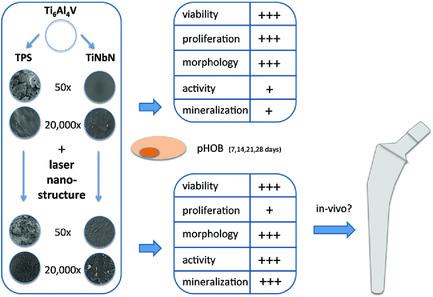当前位置:
X-MOL 学术
›
Adv. Mater. Interfaces
›
论文详情
Our official English website, www.x-mol.net, welcomes your
feedback! (Note: you will need to create a separate account there.)
Laser‐Induced Nanostructures on Titanium Surfaces as Developed in the Aeronautics and Space Industry Foster Osteoblast Activity and Function In Vitro
Advanced Materials Interfaces ( IF 4.3 ) Pub Date : 2018-10-03 , DOI: 10.1002/admi.201801125 Heidrun Jablonski 1 , Christian Wedemeyer 2 , Heike Rekasi 1 , Heiko Fietzek 3 , Tobias Mertens 3 , Max Kolb 3 , Marcus Jäger 1 , Max D. Kauther 1
Advanced Materials Interfaces ( IF 4.3 ) Pub Date : 2018-10-03 , DOI: 10.1002/admi.201801125 Heidrun Jablonski 1 , Christian Wedemeyer 2 , Heike Rekasi 1 , Heiko Fietzek 3 , Tobias Mertens 3 , Max Kolb 3 , Marcus Jäger 1 , Max D. Kauther 1
Affiliation

|
The stability of orthopedic implants is governed by the interaction between the material's surface and bone cells. Nanosized structures seem to be promising in supporting the osseointegration of total joint replacements. In order to analyze whether nanostructured titanium surfaces, as generated by a short‐pulsed Nd:YVO4 laser irradiation process developed in the aeronautics and space industry as a “cold ablation” process, can be useful for orthopedic applications, their impact on bone cells is evaluated in vitro. Cell spreading and morphology on nanostructured titanium niobium nitride or titanium plasma‐sprayed surfaces are comparable to osteoblast behavior on corresponding untreated titanium or cells grown on cover glass. However, on the nanostructured surfaces cell numbers appear to be reduced. Nonetheless, cell viability is not affected by laser pretreatment. Interestingly, osteoblast proliferation on nanostructured titanium is inhibited to the benefit of an increased production of osteoblast‐specific proteins such as bone alkaline phosphatase, osteocalcin, or procollagen. Furthermore, an enhanced mineralization of cells grown on nanostructured surfaces is confirmed in terms of an elevated hydroxyapatite deposition. Laser irradiation leads to an additional nanostructure on microstructured titanium surfaces and might positively affect the biocompatibility and ingrowth of prostheses made from the corresponding biomaterials.
中文翻译:

航空航天工业开发的钛表面上的激光诱导纳米结构促进了成骨细胞的活性和体外功能
骨科植入物的稳定性取决于材料表面与骨细胞之间的相互作用。纳米结构在支持全关节置换的骨整合方面似乎很有希望。为了分析是否由短脉冲Nd:YVO 4生成的纳米钛表面航空航天工业中开发的“冷消融”过程激光辐照工艺可用于骨科应用,可通过体外评估其对骨细胞的影响。纳米结构氮化钛铌或钛等离子喷涂表面上的细胞扩散和形态可与相应的未经处理的钛或盖玻片上生长的细胞的成骨细胞行为相媲美。但是,在纳米结构表面上,细胞数量似乎减少了。但是,细胞活力不受激光预处理的影响。有趣的是,纳米结构钛上的成骨细胞增殖受到抑制,受益于成骨细胞特异性蛋白(如骨碱性磷酸酶,骨钙蛋白或胶原蛋白)的产量增加。此外,羟基磷灰石沉积的增加证实了在纳米结构表面上生长的细胞矿化的增强。激光辐照会在微结构化钛表面上产生额外的纳米结构,并可能对由相应生物材料制成的假体的生物相容性和向内生长产生积极影响。
更新日期:2018-10-03
中文翻译:

航空航天工业开发的钛表面上的激光诱导纳米结构促进了成骨细胞的活性和体外功能
骨科植入物的稳定性取决于材料表面与骨细胞之间的相互作用。纳米结构在支持全关节置换的骨整合方面似乎很有希望。为了分析是否由短脉冲Nd:YVO 4生成的纳米钛表面航空航天工业中开发的“冷消融”过程激光辐照工艺可用于骨科应用,可通过体外评估其对骨细胞的影响。纳米结构氮化钛铌或钛等离子喷涂表面上的细胞扩散和形态可与相应的未经处理的钛或盖玻片上生长的细胞的成骨细胞行为相媲美。但是,在纳米结构表面上,细胞数量似乎减少了。但是,细胞活力不受激光预处理的影响。有趣的是,纳米结构钛上的成骨细胞增殖受到抑制,受益于成骨细胞特异性蛋白(如骨碱性磷酸酶,骨钙蛋白或胶原蛋白)的产量增加。此外,羟基磷灰石沉积的增加证实了在纳米结构表面上生长的细胞矿化的增强。激光辐照会在微结构化钛表面上产生额外的纳米结构,并可能对由相应生物材料制成的假体的生物相容性和向内生长产生积极影响。











































 京公网安备 11010802027423号
京公网安备 11010802027423号